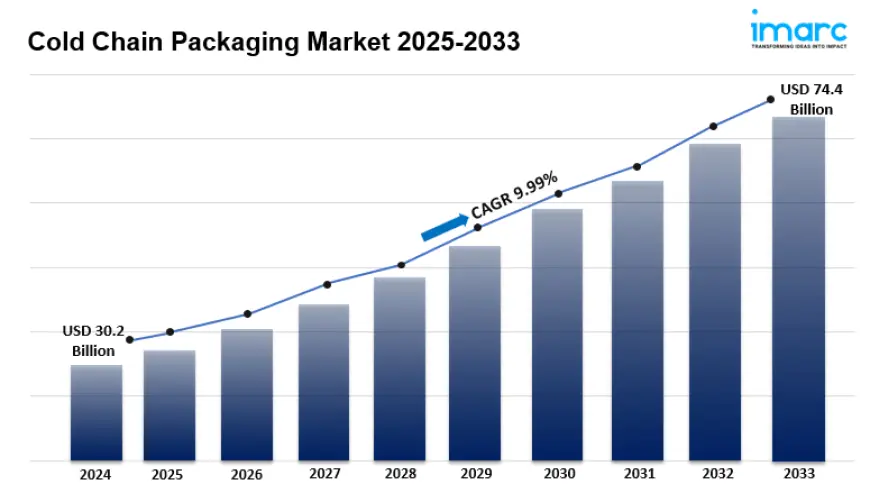Cold Chain Packaging Market Share, Demand, Key Players, Growth and Industry Trends 2025-2033
IMARC Group provides an analysis of the key trends in each segment of the global cold chain packaging market report, along with forecasts at the global, regional, and country levels for 2025-2033.

Cold Chain Packaging Industry
Summary:
- The global cold chain packaging market size reached USD 30.2 Billion in 2024.
- The market is expected to reach USD 74.4 Billion by 2033, exhibiting a growth rate (CAGR) of 9.99% during 2025-2033.
- Europe leads the market, accounting for the largest cold chain packaging market share.
- Insulated containers and boxes account for the majority of the market share in the product segment due to their excellent thermal insulation and extensive use in transporting temperature-sensitive products.
- Food holds the largest share in the cold chain packaging industry.
- The increasing demand for eco-friendly cold chain packaging is a primary driver of the cold chain packaging market.
- The growing use of passive packaging solutions is propelling the cold chain packaging market.
Industry Trends and Drivers:
- Growing Demand for Sustainable Cold Chain Packaging:
One of the major trends in the cold chain packaging market is the rising demand for sustainable packaging solutions. With increasing awareness about environmental impact and stricter regulations on plastic waste, companies are moving toward eco-friendly materials for cold chain packaging. Businesses are adopting recyclable, biodegradable, and reusable packaging solutions to minimize their carbon footprint. For instance, materials like molded pulp, plant-based insulation, and recyclable plastics are becoming popular choices in cold chain logistics. Additionally, the development of innovative insulation materials that offer the same thermal protection as traditional options but with less environmental impact is on the rise. The trend toward sustainability is particularly strong in sectors like pharmaceuticals, where temperature-sensitive medicines require reliable yet environmentally responsible packaging. With consumers and regulators alike pushing for more eco-friendly practices, companies in the cold chain packaging market are focusing on creating greener, more energy-efficient packaging solutions. As sustainability becomes a core concern for industries, the trend toward adopting sustainable cold chain packaging solutions is expected to continue growing, leading to more innovation and the use of alternative materials that ensure product safety and environmental responsibility.
- Rising Adoption of Passive Packaging Solutions:
A significant trend in the cold chain packaging sector is the rising utilization of passive packaging solutions, particularly for the transport of temperature-sensitive goods. Passive packaging systems, including insulated containers and boxes, employ advanced thermal insulation materials to sustain a designated temperature range without dependence on external energy sources such as refrigeration units. These systems are increasingly favored in sectors like pharmaceuticals, where stringent temperature control during transit is essential. The advantages of passive packaging solutions include reduced energy consumption, simplified operational processes, and cost efficiency, making them an appealing choice for businesses aiming to enhance their cold chain logistics. Additionally, advancements in phase change materials (PCMs) and vacuum insulation panels (VIPs) have significantly boosted the effectiveness of passive packaging, enabling prolonged thermal protection over extended durations. This trend is gaining momentum as companies pursue dependable, energy-efficient, and economical alternatives to conventional active packaging methods. With an increasing focus on sustainable and efficient cold chain logistics, the adoption of passive packaging solutions is anticipated to grow, particularly in the pharmaceutical and food sectors, where maintaining temperature stability is vital for product safety and quality.
- Expansion of Cold Chain Logistics in Emerging Markets:
The expansion of cold chain logistics in emerging markets signifies a notable trend within the cold chain packaging industry. As economies in regions such as Asia-Pacific, Latin America, and Africa continue to develop, there is a rising demand for temperature-sensitive products, including perishable foods, pharmaceuticals, and vaccines. This increase in demand is driving the establishment of comprehensive cold chain infrastructure, which includes packaging solutions aimed at ensuring product safety throughout transportation and storage. The growth of e-commerce, along with the rising consumption of fresh and frozen foods in these areas, further amplifies the need for efficient cold chain packaging. Additionally, governments in these emerging markets are investing in the enhancement of healthcare systems, leading to a greater volume of temperature-sensitive pharmaceutical products, such as vaccines and biologics, being transported. In response to this heightened demand, companies are developing cold chain packaging solutions tailored to the unique logistical challenges present in these regions, including varying climate conditions and inadequate transportation networks. The continuous growth of cold chain logistics in emerging markets is expected to foster innovation and investment in the cold chain packaging sector, focusing on enhancing efficiency, reliability, and cost-effectiveness.
Request Sample For PDF Report:https://www.imarcgroup.com/cold-chain-packaging-market/requestsample
Cold Chain Packaging Market Report Segmentation:
Breakup By Product:
- Insulated Container and Boxes
- Large
- Medium
- Small
- X-Small
- Petite
- Crates
- Dairy
- Pharmaceutical
- Fisheries
- Horticulture
- Cold Packs
- Labels
- Temperature Controlled Pallet Shippers
Insulated containers and boxes account for the majority of shares due to their superior thermal protection and widespread use in transporting temperature-sensitive goods.

Breakup By End User:
- Food
- Dairy
- Pharmaceutical
- Others
Food dominates the market as cold chain packaging is essential for preserving the freshness and safety of perishable food items during storage and transit.
Market Breakup by Region:
- North America (United States, Canada)
- Asia Pacific (China, Japan, India, South Korea, Australia, Indonesia, Others)
- Europe (Germany, France, United Kingdom, Italy, Spain, Russia, Others)
- Latin America (Brazil, Mexico, Others)
- Middle East and Africa
Top Cold Chain Packaging Market Leaders:
- Cascades Inc.
- Chill-Pak
- Cold Chain Technologies Inc.
- CoolPac
- Creopack Inc.
- Cryopak Industries Inc.
- DGP Intelsius Ltd.
- Pelican Products, Inc.
- Sealed Air Corporation
- Sofrigam
- Softbox Systems Ltd. (CSafe Global LLC)
- Sonoco Products Company

Note: If you need specific information that is not currently within the scope of the report, we will provide it to you as a part of the customization.
About Us:
IMARC Group is a global management consulting firm that helps the world’s most ambitious changemakers to create a lasting impact. The company provide a comprehensive suite of market entry and expansion services. IMARC offerings include thorough market assessment, feasibility studies, company incorporation assistance, factory setup support, regulatory approvals and licensing navigation, branding, marketing and sales strategies, competitive landscape and benchmarking analyses, pricing and cost research, and procurement research.












